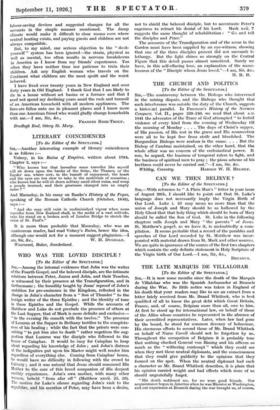WHO WAS THE LOVED DISCIPLE ?
[To the Editor of the SPECTATOR.] Sia,—Among the internal evidences that John was the writer of the Fourth Gospel, and the beloved disciple, are the intimate relations between Peter, James and John, and their Teacher, as witnessed by their presence at the Transfiguration, and in Gethsemane ; the humility taught by Jesus' reproof of John's ambition for pre-eminence in the Kingdom, reflected in the change in John's character from a " Son of Thunder " to the benign writer of the three Epistles ; and the identity of tone in these Epistles and the Gospel. While the accounts of Matthew and Liike do not preclude the presence of others at the Last Supper, that of Mark is more definite and exclusive- " in the evening He cometh with the twelve." The presence of Lazarus at the Supper in Bethany testifies to the complete- ness of his healing ; while the. fact that the priests were con- sulting " to put him also to death " rather negatives the sug- gestion that Lazarus was the disciple who followed to the house of Caiaphas. It would be easy for Caiaphas to keep silent regarding his knowledge of John ; and John's distress at the indignities put upon his Master might well render him regardless of everything else. Coming from Caiaphas' house, be would have no difficulty in following with the crowd to Calvary;, and it was natural that Jesus should commend His Mother to the care of this loved companion of His deepest earthly experiences. John's own mother, with many other women, beheld "from afar off " (Matthew xxvii. 25, 26). The motive fOr Luke's silence regarding John's visit to the Sepulchre, and his mention of Peter, may have been a desire, not to shield the beloved disciple, but to accentuate Peter's eagerness to retract his denial of his Lord. Mark xvii. suggests the same thought of rehabilitation : " Go and tell the disciples and Peter."
The accounts of the Transfiguration and of the scene in the Garden must have been supplied by an eye-witness, showing that one of the three disciples present did not succumb to lethargy. But the light shines so strongly on the Central Figure that this detail passes almost unnoticed. Surely we have, in this self-effacing love, an explanation of the name- lessness of the " Disciple whom Jesus loved."—I am, Sir, &c., M. R. B.






































 Previous page
Previous page